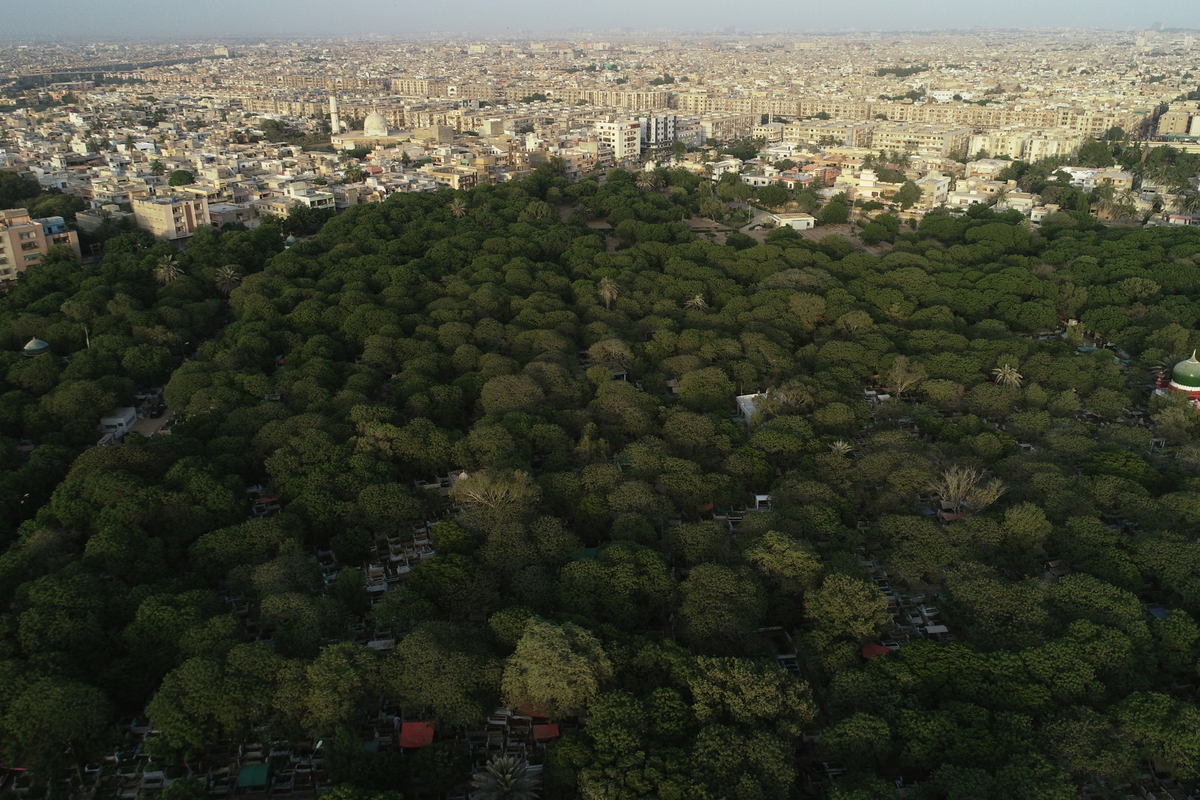Pakistan’s first line of defense against floods and heatwaves is disappearing
Rapid deforestation, rising temperatures and extreme rainfall are leaving millions exposed to disasters once mitigated by ancient forests

Asma Kundi
Producer, Islamabad
Asma Kundi is a multimedia broadcast journalist with an experience of almost 15 years. Served national and international media industry as reporter, producer and news editor.

Aerial view of Azadirachta Indica trees over a Karachi graveyard.
Reuters
As climate disasters intensify worldwide, Pakistan is facing a perilous environmental tipping point. Its natural forests - the country’s frontline defense against floods, landslides and heatwaves - are disappearing at an alarming rate.
Rapid deforestation, coupled with rising temperatures and extreme rainfall, is leaving millions exposed to disasters that were once mitigated by these ancient woodlands.
Shrinking forests, growing risks
Environmental assessments paint a stark picture: Pakistan’s forests now cover only about 4.8 million hectares, roughly 5 percent of the country’s land area, according to the World Bank and WWF-Pakistan. Over the past two decades, the nation has lost nearly 20 percent of its forest cover, shrinking from 45,100 square kilometers in 2000 to 36,900 square kilometers by 2021, according to Pakistan Institute of Development Economics (PIDE).
The pace of loss is relentless. A 2016-2020 forest assessment reported an annual disappearance of around 11,000 hectares, with more than 150,000 hectares of natural forests—particularly in the Himalayas, Karakoram, Hindukush, and Sulaiman ranges - degrading each year. These forests, once a crucial defense against landslides, soil erosion, and flash floods, are diminishing in both size and quality.
Global Forest Watch data (2023–2025) underscores the crisis: Pakistan has lost 9,000–10,000 hectares of tree cover annually between 2001 and 2023, with over 1,500 wildfire alerts recorded in 2025 alone.
The human and economic toll
The consequences of deforestation are already catastrophic. Between 1950 and 2011, Pakistan experienced 19 major floods, claiming over 10,600 lives and causing more than $30 billion in economic losses, according to the Federal Flood Commission. In 2022, floods displaced 33 million people, destroyed 16,000 square kilometers of farmland, and inflicted $30 billion in damages, as reported by the National Disaster Management Authority (NDMA).
In 2025, monsoon floods across Khyber Pakhtunkhwa, Punjab, and Gilgit-Baltistan killed thousands, with deforested watersheds exacerbating the destruction. Beyond floods, deforestation has intensified heatwaves, reduced biodiversity, and worsened food insecurity. The Pakistan Meteorological Department reported three heatwaves in 2025, with temperatures in Nawabshah soaring to 50°C, 5-8 degrees above the seasonal average.
Plantations cannot replace natural forests
Despite initiatives like the Billion Tree Afforestation Program (2014–2018, Khyber Pakhtunkhwa) and the ongoing Ten Billion Tree Tsunami (2019-present), experts warn that new plantations cannot replace centuries-old natural forests. Mature trees play a critical role in stabilizing soil and regulating water flow; their loss accelerates erosion, landslides, and flood severity, especially in mountainous regions.
Muhammad Ibrahim Khan, Director of Forests at WWF-Pakistan, explained that the country has nine distinct forest types—from coastal mangroves and riverine forests along the Indus to scrub forests in the plains, and chil pine, moist temperate, dry temperate, alpine, and sub-alpine scrubs in high mountains. He warned that commercially valuable species like deodar and spruce are under extreme pressure from deforestation and climate change.
“Between 2016 and 2020, about 11,000 hectares of forest were lost annually, with more than 150,000 hectares of intact natural forests degraded each year. The decline in high-value species and tree cover is alarming,” Khan said.
Northern forests in the Himalayas, Hindukush, Karakoram, and Sulaiman Range are especially vulnerable. “Removing mature trees triggers erosion and landslides. With climate change increasing rainfall intensity, the damage multiplies,” he noted.
While plantation campaigns reduce some pressure, Khan emphasized that natural forests cannot be replaced quickly. “Once natural forests disappear, restoration may take decades. Plantations increase green cover, but they don’t restore the full ecological function of mature forests,” he said.
Khan urged urgent land-use planning, zoning, and alternative livelihoods for communities dependent on forest resources. “Infrastructure development without safeguards is another major threat. Protecting sensitive ecosystems is critical; otherwise, restoration may become nearly impossible,” he warned.







Comments
See what people are discussing